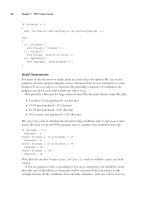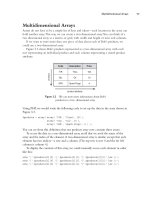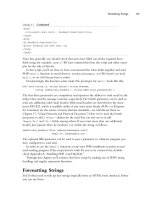PHP and MySQL Web Development - P21 pps
Bạn đang xem bản rút gọn của tài liệu. Xem và tải ngay bản đầy đủ của tài liệu tại đây (80.64 KB, 5 trang )
67
File Locking
customer calls fopen() and also begins writing? What will be the final contents of the
file? Will it be the first order followed by the second order or vice versa? Will it be one
order or the other? Or will it be something less useful, like the two orders interleaved
somehow? The answer depends on your operating system, but is often impossible to
know.
To avoid problems like this, you can use file locking.This is implemented in PHP
using the flock() function.This function should be called after a file has been opened,
but before any data is read from or written to the file.
The prototype for flock() is
bool flock(int fp, int operation [, int &wouldblock])
You need to pass it a pointer to an open file and a number representing the kind of
lock you require. It returns true if the lock was successfully acquired, and false if it was
not.
The possible values of operation are shown in Table 2.2.The possible values
changed at PHP 4.0.1. Both sets of values are shown in the table.
Tab le 2.2 flock() Operation Values
Value of operation Meaning
LOCK_SH (formerly 1) Reading lock.This means the file can be shared with other
readers.
LOCK_EX (formerly 2) Writing lock.This is exclusive.The file cannot be shared.
LOCK_UN (formerly 3) Release existing lock.
LOCK_NB (formerly 4) Adding 4 to the operation prevents blocking while trying to
acquire a lock.
If you are going to use flock(),you will need to add it to all the scripts that use the
file; otherwise, it is worthless.
Note that flock() does not work with NFS or other networked file systems. It also
does not work with older file systems that do not support locking such as FAT. On some
operating systems it is implemented at the process level and will not work correctly if
you are using a multithreaded server API.
To use it with this example, you can alter processorder.php as follows:
$fp = fopen("$DOCUMENT_ROOT/ /orders/orders.txt", 'a');
flock($fp, LOCK_EX); // lock the file for writing
fwrite($fp, $outputstring);
flock($fp, LOCK_UN); // release write lock
fclose($fp);
You should also add locks to vieworders.php:
$fp = fopen("$DOCUMENT_ROOT / /orders/orders.txt", 'r');
flock($fp, LOCK_SH); // lock file for reading
04 525x ch02 1/24/03 3:38 PM Page 67
68
Chapter 2 Storing and Retrieving Data
// read from the file
flock($fp, LOCK_UN); // release read lock
fclose($fp);
Our code is now more robust, but still not perfect.What if two scripts tried to acquire a
lock at the same time? This would result in a race condition, where the processes com-
pete for locks but it is uncertain which will succeed, that could cause more problems.We
can do better by using a DBMS.
Doing It a Better Way: Database Management
Systems
So far all the examples we have looked at use flat files. In the next section of this book
we’ll look at how you can use MySQL, a relational database management system,
instead.You might ask,“Why would I bother?”
Problems with Using Flat Files
There are a number of problems in working with flat files:
n
When a file gets large, it can be very slow to work with.
n
Searching for a particular record or group of records in a flat file is difficult. If the
records are in order, you can use some kind of binary search in conjunction with a
fixed-width record to search on a key field. If you want to find patterns of infor-
mation (for example, you want to find all the customers who live in Smalltown),
you would have to read in each record and check it individually.
n
Dealing with concurrent access can become problematic.We have seen how you
can lock files, but this can cause a race condition as we discussed earlier. It can also
cause a bottleneck.With enough traffic on the site, a large group of users may be
waiting for the file to be unlocked before they can place their order. If the wait is
too long, people will go elsewhere to buy.
n
All the file processing we have seen so far deals with a file using sequential pro-
cessing—that is, we start from the start of the file and read through to the end. If
we want to insert records into or delete records from the middle of the file (ran-
dom access), this can be difficult—you end up reading the whole file into memo-
ry, making the changes, and writing the whole file out again.With a large data file,
this becomes a significant overhead.
n
Beyond the limits offered by file permissions, there is no easy way of enforcing dif-
ferent levels of access to data.
04 525x ch02 1/24/03 3:38 PM Page 68
69
Next
How RDBMSs Solve These Problems
Relational database management systems address all of these issues:
n
RDBMSs can provide faster access to data than flat files. And MySQL, the database
system we use in this book, has some of the fastest benchmarks of any RDBMS.
n
RDBMSs can be easily queried to extract sets of data that fit certain criteria.
n
RDBMSs have built-in mechanisms for dealing with concurrent access so that you
as a programmer don’t have to worry about it.
n
RDBMSs provide random access to your data.
n
RDBMSs have built-in privilege systems. MySQL has particular strengths in this
area.
Probably the main reason for using an RDBMS is that all (or at least most) of the func-
tionality that you want in a data storage system has already been implemented. Sure, you
could write your own library of PHP functions, but why reinvent the wheel?
In Part 2 of this book,“Using MySQL,” we’ll discuss how relational databases work
generally, and specifically how you can set up and use MySQL to create database-backed
We b sites.
Further Reading
For more information on interacting with the file system, you can go straight to Chapter
16,“Interacting with the File System and the Server.” In that section, we’ll talk about
how to change permissions, ownership, and names of files; how to work with directories;
and how to interact with the file system environment.
You may also want to read through the file system section of the PHP online manual
at />Next
In the next chapter, we’ll discuss what arrays are and how they can be used for process-
ing data in your PHP scripts.
04 525x ch02 1/24/03 3:38 PM Page 69
04 525x ch02 1/24/03 3:38 PM Page 70
3
Using Arrays
THIS CHAPTER SHOWS YOU HOW TO
use an important programming construct—arrays.
The variables that we looked at in the previous chapters are scalar variables, which store a
single value. An array is a variable that stores a set or sequence of values. One array can
have many elements. Each element can hold a single value, such as text or numbers, or
another array. An array containing other arrays is known as a multidimensional array.
PHP supports both numerically indexed and associative arrays.You will probably be
familiar with numerically indexed arrays if you’ve used any programming language, but
unless you use PHP or Perl, you might not have seen associative arrays before.Associative
arrays let you use more useful values as the index. Rather than each element having a
numeric index, they can have words or other meaningful information.
We will continue developing the Bob’s Auto parts example using arrays to work more
easily with repetitive information such as customer orders. Likewise, we will write short-
er, tidier code to do some of the things we did with files in the previous chapter.
Key topics covered in this chapter include
n
Numerically indexed arrays
n
Associative arrays
n
Multidimensional arrays
n
Sorting arrays
What Is an Array?
We looked at scalar variables in Chapter 1,“PHP Crash Course.”A scalar variable is a
named location in which to store a value; similarly, an array is a named place to store a
set of values, thereby allowing you to group scalars.
Bob’s product list will be the array for our example. In Figure 3.1, you can see a list
of three products stored in an array format and one variable, called $products, which
stores the three values. (We’ll look at how to create a variable like this in a minute.)
05 525x ch03 1/24/03 2:56 PM Page 71









